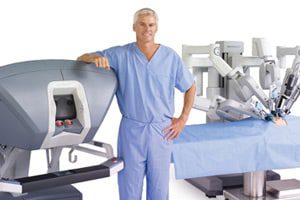
In the midst of growing controversy over its robotic surgical system, Intuitive Surgical continues to add functionality to its da Vinci robot. Ho-Sheng Lin, M.D., a fellow with the American College of Surgeons and professor of otolaryngology-head and neck surgery in the School of Medicine and Karmanos Cancer Institute, reported what were described as promising […]
 In the midst of growing controversy over its robotic surgical system, Intuitive Surgical continues to add functionality to its da Vinci robot.
In the midst of growing controversy over its robotic surgical system, Intuitive Surgical continues to add functionality to its da Vinci robot.
Ho-Sheng Lin, M.D., a fellow with the American College of Surgeons and professor of otolaryngology-head and neck surgery in the School of Medicine and Karmanos Cancer Institute, reported what were described as promising results for the treatment of sleep apnea utilizing transoral robotic surgery (TORS), according to Science Daily. The study results appear in last month’s issue of The Laryngoscope.
A small study looked at the treatment of obstructive sleep apnea/hypopnea syndrome (OSAHS). Not all OSAHS patients tolerate the traditional treatment—positive airway pressure (PAP)—long considered an extremely safe and efficacious treatment. PAP involves wearing a mask when sleeping and keeps the airway open so the patient may continue breathing with no interruption, according to Science Daily, which noted that the research involved a small sample size.
Meanwhile, although Intuitive Surgical continues to tout the controversial system’s so-called benefits, mounting injury reports and litigation tell a different story.
In robotic-assisted surgery, a surgeon sits at a console operating multiple robotic arms that manipulate tiny tools that are inserted into the patient’s body via small incisions. The system uses a small, lighted camera that displays the surgical area in 3-D video. The da Vinci is the only robotic surgery approved by the U.S. Food and Drug Administration (FDA) for soft tissue surgeries.
Recently, Intuitive Surgical dropped its stock price significantly in the face of stalled sales, a warning from federal regulators, and mounting injury reports and litigation.
As we’ve written, in the face of growing patient injuries, some hospitals are opting against using the technology, which is expensive. In fact, oncologist Dr. Ezekiel Emanuel, a former White House adviser, agreed with a 2012 op-ed piece published in The New York Times saying, “This is a pseudo-innovation … a technology that increases costs without improving patients’ health,” The Monterey Herald reported.
da Vinci training protocols have also come under fire. Dr. Jim Hu, chief of minimally invasive surgery at the UCLA Medical School, urology department, performed over 1,500 da Vinci surgeries and has conducted many studies of the da Vinci. Dr. Hu explained that it takes some 250-700 procedures for a surgeon to master the da Vinci, according to The Monterey Herald. Not all hospitals mandate that surgeons conduct this many training procedures—so-called “proctored” surgeries and Intuitive only provides surgeons with two days of training.
The U.S. Food and Drug Administration (FDA) recently criticized Intuitive Surgical saying that the device maker never reported the steps it took to protect patients from accidental electrical burns, according MedScape Medical News, citing a May 30 FDA inspection report. The report followed agency inspections conducted in April and May.
Personal injury lawsuits brought over the da Vinci allege that the system caused severe internal injuries such as burns, tears, and other complications. Some procedures have led to chronic pain, disability, or death. Lawsuits also blame Intuitive’s aggressive marketing tactics, which appear to be meant to urge hospitals to purchase the expensive robotic device, and allege that design flaws inherent in the da Vinci, as well as poor physician training on the device, have been tied to serious injuries. Some 89 deaths have been associated with the da Vinci robotic surgical systems since 2009.


